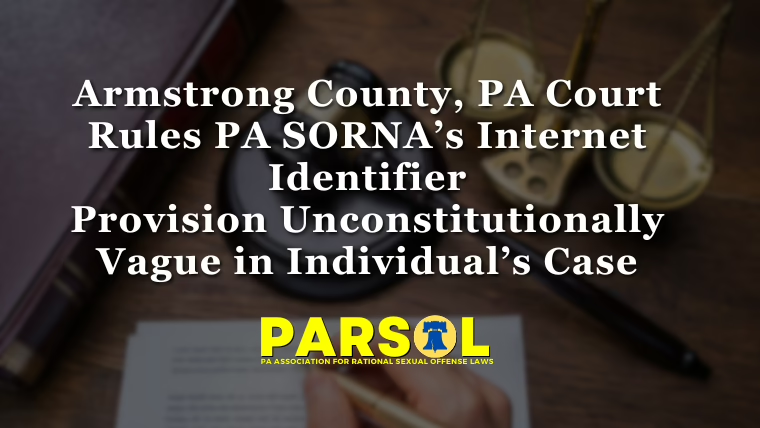Today the U.S. Sentencing Commission released its 2025 amendments to the Federal Sentencing Guidelines. The amendments will take effect in 6 months unless Congress overrides them.
ACTION NEEDED:
USSC is seeking comment on retroactivity of the amendments.
- Impact Analysis of Certain 2025 Amendments if Made Retroactive (May 15)
- Public Comment Submission Portal
Comment Deadline: June 2
ANALYSIS:
The below analysis uses the term “sex offender” in direct quote reference to the USSC’s language in the guidelines and is not intended to be diminutive.
The 2025 amendments move away from a one-size-fits-all approach for “sex offenders” and persons convicted of sex crimes. Courts now have greater discretion to tailor both the imposition and length of supervised release to the individual, based on a thorough assessment of the case, while still maintaining the ability to impose strict conditions and lengthy supervision where warranted by statute or case facts. The amendments emphasize rehabilitation, public safety, and efficient use of supervision resources, while retaining robust tools for monitoring and restricting sex offenders as needed.
Supervised Release: Shift to Individualized Assessment
The amendments eliminate the previous guideline recommendation that courts impose the statutory maximum term of supervised release for sex offenses. Instead, courts are now instructed to conduct an individualized assessment to determine both whether supervised release is warranted and, if so, its appropriate length, provided it meets any statutory minimums and does not exceed statutory maximums.
- The court must state in open court the reasons for imposing or not imposing supervised release and for the length of the term imposed.
- The amendments explicitly note that, while a statutory maximum term may still be warranted in certain sex offense cases, it is no longer the default recommendation; the decision is left to the court’s discretion based on the facts of the case.
Special Conditions
The guidelines continue to recommend certain “special conditions” for individuals convicted of sex offenses, including:
- Mandatory participation in a treatment and monitoring program for sex offenders.
- Restrictions on computer and internet use if relevant to the offense.
- Consent to searches of person and property (including electronic devices) upon reasonable suspicion.
- Prohibition on contacting victims, either directly or indirectly.
The definition of “sex offense” for these purposes remains unchanged: it includes offenses perpetrated against minors under specified federal statutes, attempts or conspiracies to commit such offenses, but excludes failure to register under 18 U.S.C. § 2250.This probably means that a failure to register is, as we have been saying forever, “recidivism” but not “reoffense.”
Supervised Release Considerations
If a person with a sex offense violates their supervised release, courts are encouraged to use a flexible, individualized approach, considering a range of responses (not just revocation and imprisonment), with the primary goal being rehabilitation and public safety rather than punishment for new criminal conduct. I believe this is especially helpful when considering the technical violations related to registry-related technical violations.
The guidelines clarify that, upon revocation for a sex offense, the court may impose a new term of supervised release, not to exceed the original statutory maximum, minus any imprisonment imposed for the violation.
Removal of Automatic or Reflexive Supervision
The amendments respond to concerns that supervised release was often imposed reflexively, even when not needed. Now, supervised release should be ordered only when an individualized assessment shows it is warranted, ensuring resources are focused on those who need supervision most.
No Change to Statutory Minimums or Maximums
The amendments do not alter statutory minimum or maximum terms of supervised release for sex offenses. For certain sex offenses, Congress (not USSC) still requires a minimum of five years and allows up to life on supervised release.
Victim Protection and Notification
Courts are encouraged to ensure that victims are notified and have an opportunity to be heard regarding modifications or early terminations of supervised release conditions relevant to them, including in sex offense cases.
Summary Table: Previous vs. Amended Guidelines for Sex Offenders
| Aspect | Previous Guidelines | 2025 Amendments |
| Recommended Supervised Release | Statutory maximum recommended for sex offenses | Individualized assessment; no default maximum |
| Length of Supervision | Often set at maximum by default | Determined case-by-case, within statutory limits |
| Special Conditions | Required (treatment, monitoring, etc.) | Still required; list clarified and expanded |
| Victim Contact Restrictions | Imposed as special condition | Explicitly listed as a special condition |
| Revocation Response | Focused on revocation and imprisonment | Encourages graduated, rehabilitative responses |
| Victim Notification | Not always explicit | Now encouraged for changes affecting victims |



![stuckIn1995_rally_header - PARSOL - Pennsylvania Assoc for Rational Sex Offense Laws (PA Megan's Law Resources) PARSOL Board Chair Josiah Krammes speaks at the PA Capitol Rotunda flanked by State Reps. Emily Kinkead and Tim Briggs (28 Oct 2025) [John Dawe/PARSOL]](https://parsol.org/wp-content/uploads/2025/10/stuckIn1995_rally_header.avif)
